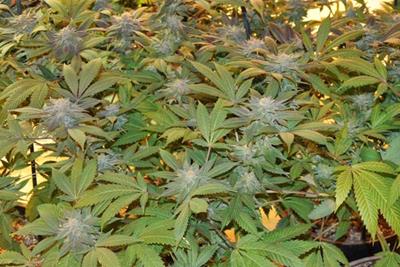
Friday November 6, 2015
By Tyler Terps
 Growing
Growing
Cannabis, like many plants, can be grown in more than one way. Most people think of roots growing in soil, but hydroponics offers the ability to work in smaller spaces with more control over your green’s food source. If you’re looking for flavor and forgiveness in the occasional mistake, take up the traditional soil method. Of course, any experienced grower will have a preference with first-hand accounts of why they stick with their technique. If you’re looking to plant a marijuana seed and help it grow, there are a few things you should consider before planning things out.
Soil
Cannabis plants prefer rich soil that allows for maximum drainage, in fact, many growers switch out soil for perline to increase drainage. Nutrient rich materials like earthworm castings or manure can be added to improve the health of your greens and make sure the crop gets everything it needs. Plants absorb nutrients from soil, so during the flowering stage it’s important to use just the right kind and amount of nutrients to maximize your yields and prevent any a nutrient deficiency. Even with the best soil you will still need to supplement some nutrients to maximize your results.
Pros/Cons
Pros:
- Can be more forgiving for inattentive growers
- Growing in soil is easier than some types of hydroponic growing
- Better flavor in the end
- Natural product
Cons:
- It takes up a lot of space
- It is usually more expensive
- Problems take longer to become evident and be recovered
- Doesn’t produce as high of a volume of nutrients than hydroponics do
Hydro
Hydroponics is growing cannabis by using any growing medium other than soil. These alternatives (which are often combined) include gravel, coco coir, sand, mister air, vermiculite, peat moss, perlite, hydroton, and/or just water. During the entire process you must provide the plant with all its nutrients by way of its water supply.
Hydroponic systems come in different forms, here are the top 5 common forms: aeroponics, deep water culture, drip irrigation, nutrient film technique, and ebb-and-flow.
1. Aeroponics
Aeroponics uses a grow chamber to suspend roots in the air with no medium inside of a closed-loop system. Water, rich with nutrients, douses the bases of these plants as they hang in the air. By providing an oxygen-rich environment, the microbes on the plant are able to digest and process the nutrients for its circulatory system.
2. Deep Water Culture
Deep Water Culture is a method of growing which uses a bucket of nutrients, also called bubblers. The plants are suspended over the nutrients as the roots grow into the nutrients below. The bubblers’ mixture is filled with air using an aquarium pump and pays off by speeding up the growtime. The oxygen and fertilizer enriched mixture work wonders for the end product.
3. Drip Irrigation
The drip irrigation system feeds each plant individually in its own chamber. Nutrients are administered by a dripper, and then the solution is recycled, much like the already mentioned methods. Each plant is located in separate chambers where the nutrients are fed to the medium by means of a small dripper.
4. Nutrient Film Technique
The Nutrient Film Technique is a hydroponic method which involves a nutrient solution being pumped onto a tray or gulley to form a shallow and slow moving film that moves through the plant’s roots. These roots grow into the solution, creating a large root mat in the tray. Having round the clock access to water and nutrients along with more than enough oxygen for the roots, makes for rapid development with maximum yields.
5. Ebb-And-Flow
Ebb and Flow replaces soil with a medium like rockwool to produce very large yields. This type of system stimulates a natural cycle of rain and the time in between it, therefore giving off a more natural environment for your grow.
Pros/ Cons
Pros:
- Maximize yields by accurately providing just the right amount of nutrients to your cannabis
- Soil born diseases and pests are less likely because of the lack of soil and the grow is usually indoor
- Larger yield
- Problems are easier to correct because you’re more in control
- Doesn’t take up a lot of space
- Get a result quicker
- Better looking product “in the bag”
- Grows are able to be automated by using techniques like bubbleponics and deep water culture
Cons:
- A lot more maintenance cleaning the equipment
- Doesn’t taste as well as soil grown
- Need to pay a lot of attention during the entire process
Photo Credit: (license)







